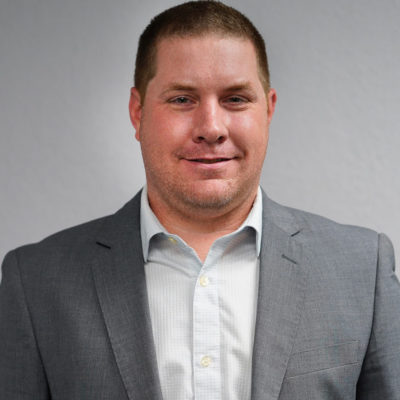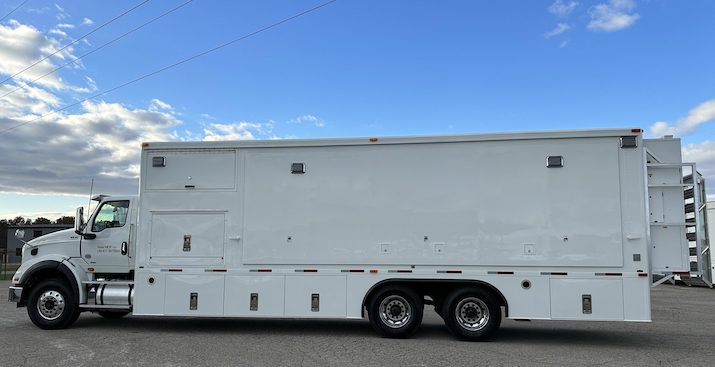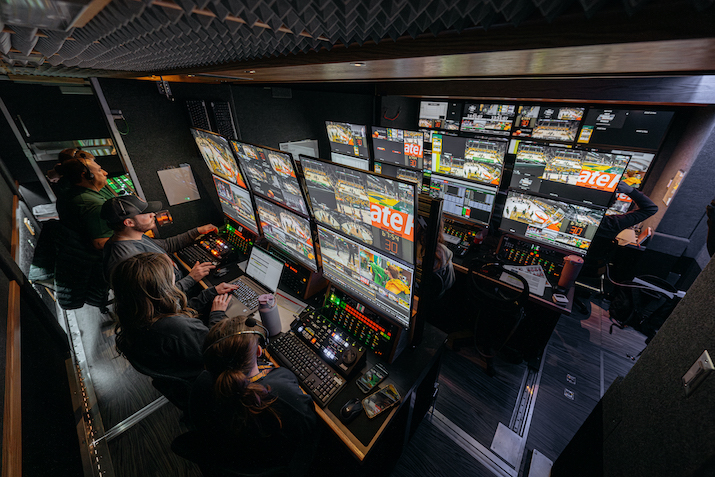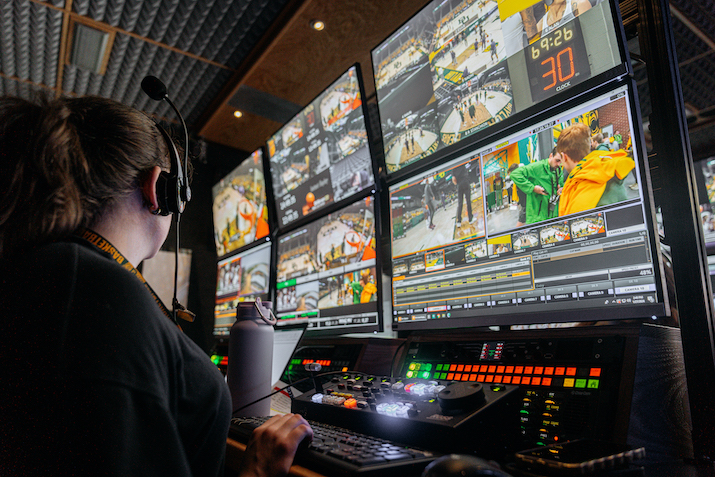SVG Sit-Down: Ross Production Services’ Stephen Repass Says New RPS9 4K Truck ‘Opens Doors’
Moving beyond Sprinter vans, the company targets larger, more-complex projects
Story Highlights
At the beginning of the year, Ross Production Services (RPS) rolled out its largest, most powerful mobile unit to date: RPS9. Fully equipped with the latest Ross Video technology, the 40-ft. double-expando truck represents a concerted effort to grow beyond the Sprinter vans currently in its fleet and tackle bigger events in both the sports and entertainment industries.
CLICK HERE for a full video walkthrough of the new mobile unit.
In addition to RPS9, the company continues to expand its DISTRO (distributed production) and REMI services from its 30,000-sq.-ft., state-of-the art facility in Connecticut equipped with three control rooms.
SVG sat down with Ross Production Services VP Stephen Repass to discuss the intent behind the launch of RPS9, the evolution of the REMI-production market, today’s big technology trends, the challenge of finding quality crew and technicians, and what’s ahead for RPS in 2024.

Ross Production Services’ Stephen Repass: “[With so many digital platforms that need more content, there’s a huge opportunity for lower-tier sports, and we help them put on a high-quality production.”
RPS9 is two years in the making, so it has been a long process. We built it to show the world what we’re about as a full-service production company, not just a Sprinter-van company. Our clients are asking for more and more technology and creative options these days, and, while we love the Sprinters, the small space brings a lot of constraints.
We want to be able to say yes to those options now and in the future. It’s not just about having technicians in the chair. It’s about having the right equipment and resources to pull off bigger shows, provide more flexibility to our customers, and offer services like 4K. This is a true 4K truck; we’re not converting anything.
What opportunities does this new truck provide that weren’t possible with your existing mobile units?
The sizing and spacing of the truck is opening doors for us that our Sprinter fleet couldn’t. We’re going after larger and more complex projects with some major sports broadcasters whose names we can’t commit to paper right now. Generally, it means we can say yes to a lot more.
What markets do you see as the biggest opportunities for growth right now, and how does RPS9 help you to better serve them?
We want to get more involved in entertainment — more shows, bigger productions — and RPS9 gives us the flexibility and capability to do that. Our clients are asking for it, and this new truck means we can show them that they don’t need a 53-ft. truck, that a 40-ft. truck can do the same. The way we have built the truck to handle DISTRO and REMI, we don’t need 23 seats; we just need a bigger truck to fit all the equipment to make it happen.
Do you expect to launch more units similar to this truck?
RPS9 is the first of many in our plan. A truck this size and capable opens the doors — from a truck-rental standpoint — to be able to do championship-level broadcasts, much bigger shows with 16 or 17 cameras, four or five tape machines, etc. Right now, we’re maxing out the [existing] Sprinters with the shows we are committed to, but RPS9 gives us the resources and flexibility that we didn’t have in our existing fleet.

RPS9 is Ross Production Services’ eighth and largest truck. The 40-ft. box truck with dual expanding sides was designed and integrated in partnership with BeckTV.
That allows us to commit to more and expand our horizons, not just from a network standpoint but from a league standpoint, and to get directly involved with the league entertainment companies looking for true 4K entertainment trucks that a Sprinter just can’t currently handle.
We want to let people know that we’re not just a traditional stick–and-ball company. We can do more than simple four-camera basketball shoots, and, with RPS9, we can do them with higher quality and more efficiency.
Tell us a bit about the design and gear inside RPS9.
We have the brand-new TouchDrive TD4 [control panel], and I’m pretty sure we’re the first company in North America, maybe the world, to put that into a truck. We have the Ultrix Acuity FR-12 [switcher], and we’re the first company in North America to put that in a truck, too. [We have] Xpression [graphics], MIRA [replay], and Piero [sports graphics]. We have a spot for Voyager VR systems, Clear-Com intercom with Agent-IC remote intercom users, and a Calrec Apollo audio console. It is the best-of-the-best when it comes to the latest production tech, and it’s wired for 12 cameras. It needs that to get the best results; you just can’t fit equipment that big or powerful into a Sprinter.
Are 4K or HDR on your near-term roadmap? Are your customers demanding either, or is this still not a major focus for them?
We are seeing several networks [that we work with] getting more and more involved with HDR. So HDR is something [we do] with at least one of our linear production partners. 4K not so much — yet. The main reason we built the truck 4K-ready is to expand into entertainment.

To equip the new RPS9 truck, Ross Production Services leverages the full range of Ross Video’s latest video-production equipment.
Are you seeing more REMI productions these days? Or is there a return to fully onsite shows? Either way, what has the effect been on your business?
REMI has been around a long time. One thing people think when they think of REMI is “I’m going to save money,” but that’s often not the case. You still need to bring those feeds into your control room. We often end up asking questions like: Do you have your own transmission solution? Do you have to rent a LiveU? Do you have to pay a third party to bring transmission feeds to your control room? That could end up costing thousands of dollars, depending on the number of feeds you want. And then, do you have the staff and resources available to operate the control-room gear? Are you using freelancers? Are they local, or are you flying people in?
We saw a real pivot during the pandemic. What we created at Ross and RPS was what we like to call DISTRO, or distributed production. DISTRO started with controversial questions: Why do you need a control room at all? Why send all those feeds to a control room that costs thousands of dollars when you could just have people sitting at home, remoting into the gear using our ‘secret sauce’ that we’ve created in the cloud and allows operators to work from their home office. Graphics operators for 90% of our shows are sitting at home, as are the second, third, and fourth replay operators. That helps us get more equipment into the truck itself because we don’t need 20-25 seats. They get the same multiviewers that you get in a truck; they get the same intercom solution they would get in a truck. It’s almost like you’re in a truck, but you get to eat your own food and sleep in your own bed when the shoot is over.
This allows us to offer our clients flexibility (depending on their needs), available resources, and budget constraints. Whether that’s a full onsite production, a REMI production, a DISTRO production, or a mix of all three. Whatever it takes to get the best results for the producer, we can make it happen.
More live sports coverage is being produced today than ever before. How has this affected your business — especially for lower-tier, niche, and streaming-only productions?
There are so many digital platforms that need more content. That’s a huge opportunity for lower-tier sports, and we are there to help them put on a high-quality production that competes with more established sports.
You have new digital platforms like FUBO, FloSports, DAZN, etc., and they’re looking for a more cost-effective solution. They want good quality, but they can’t afford the same level production as a linear ESPN broadcast.
That’s why DISTRO is a big advantage for them. One of the biggest expenses for productions is T&E, time and travel expenses. You still need to pay people with a DISTRO production, but you don’t have to pay for their travel, meals, hoteling, insurance, etc. It also means paying for much less time because they’re working only the four or five hours needed for the event. That lowers the bar for entry for many of these upstart broadcasters and new leagues and sports to get on-air and start building an audience.

RPS9 rolled out for its first event at Baylor University to broadcast men’s basketball on ESPN+ on Jan. 2.
What technical challenges do you see as the most vexing for your engineering team these days?
The biggest technical challenge right now is adding more and more equipment for higher-demand clients and reducing the amount of time needed to set it up. Our clients want more for less, and they want unique camera shots or audio pickups, but they don’t necessarily have the budget to pay for it all — and they want to do it all in one day. There’s so much competition now that people just can’t afford the same level of production they could five years ago, but viewers still expect that same quality. Everyone is fighting tooth-and-nail to do more and be more creative: they need a $100K show, but they have only a $50K budget.
That has forced us to look for ways to deliver what they want in more cost-efficient ways, which we always enjoy and have had a lot of success doing. For example, our “field fiber kits” can reduce setup time for audio, video, and networking infrastructure on set by at least two-thirds versus a traditional truck with analog DT and standalone fiber converters.
Outside of technological challenges, what are your biggest concerns/challenges today?
The biggest challenge across the industry is finding the right people. There are more productions than ever and fewer people to put those productions on. Experienced technicians and operators are retiring and not being replaced. There’s no path to the next generation of technicians. That’s partly because people got used to working from home during the pandemic, partly because fewer newcomers and younger generations are coming out college and getting into the field, and partly because of the requirements of the job. There are a lot of days away from home. It’s tough, physical, often stressful, and highly demanding work, and that’s not what many people are looking for.
Is there a specific technology (or technologies) that clients are demanding more often these days?
The thing most clients are mostly looking for is to be different. They want new shots, more angles, new sounds. They want to stand out from the growing field of competitors. Recently, we have seen camera operators on the field (or ice) during the game. That’s the first time that has happened.
Each of these creative experiments brings its own technical challenges, whether that’s the cameras or the audio or virtual signage and augmented-reality features. The nice thing about being part of Ross is that we have access to all the technology to do that. We can give you that sound bite. We can give you those angles or movements. We can give you that virtual signage or virtual augmentation.
What’s on RPS’s agenda in 2024?
Mostly, I’m excited about getting out there and showing people what we can do and showing them what can be done with the best of Ross. We have RPS9, arguably the most capable OB truck on the market. We have the 30,000-sq.-ft. state-of-the art facility in Connecticut with three control rooms. We plan to do some exciting things with Spidercam, too.
